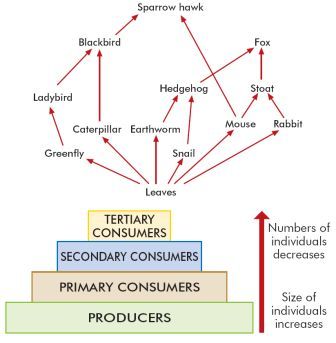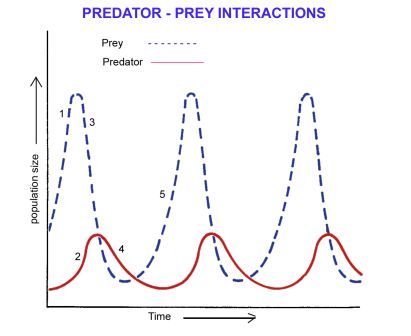Ecology
Ecology: the study of how living organisms interact with each other and with their environment.
Abiotic Factors: non-living factors in the environment.
Habitat: the place where an organism lives.
Population: the number of individuals of the same species.
Community: The plants and animals in an ecosystem.
Ecosystem: a community of organisms and the habitat’s non-living components.
Biosphere: the place on earth where life can occur.
An organisms niche is its functional role in the ecosystem eg a ladybird occupies the secondary consumer role as its niche.
Living organisms are affected by biotic factors (the effect of other living organism) and abiotic factors: (the effect of non-living parts of the organism’s habitat) Abiotic factors include climatic conditions such as temperature, rainfall, day length, humidity, wind, atmospheric pressure and edaphic factors are related to soil e.g. pH, aeration, porosity, water content, mineral nutrients, humus, soil type. Aquatic factors include wave action, tides, submergence time, exposure time, salinity, oxygen concentration, currents and light quality.
Feeding Relationships
A producer (Autotroph) makes its own food from inorganic materials either by photosynthesis or chemosynthesis (some bacteria in soil) and provides food for consumers. A consumer (Heterotroph): cannot make food. Herbivores eat plants only, carnivores eat flesh of other animals. Omivores such as hedgehogs and field mice eat both plant and animal material. Decomposers such as earthworms, most bacteria and fungi break down dead organic matter so that it can be recycled.
Food Chains
Food Chains show the direction food energy is passed as animals feed
Eg Grass →Rabbit → Fox
Bramble →Aphid →Ladybird → Sparrow
The trophic level shows the position of a species in a food chain. Producers are found on the first trophic level, herbivores are found of the second level and so on. Food chains are usually short because of the inefficiency of energy transfer to the next trophic level. Almost 90% of an organism’s food is used in respiration so very little is left to be passed on to the next trophic level.
Linking food chains makes a food web.
A Pyramid of Numbers is a chart showing the number of individuals at each trophic level of a food chain. Normally the numbers of individuals decreases up the food chain. Large trees are exceptions as a single organism can provide food for many smaller consumers.

Nitrogen fixing bacteria convert atmospheric nitrogen into nitrates that plants can absorb. Decomposing bacteria break down organic matter into ammonia. Nitrifying Bacteria convert ammonia and nitrates to nitrate. Denitrifying Bacteria convert nitrites and nitrates back into atmospheric nitrogen.
Photosynthesis removes carbon atoms from the air as CO2 in photosynthesis.
Respiration and burning returns CO2 to the air.
An increase in burning fossil fuels can lead to an enhanced greenhouse effect.
Competition
Competition is the rivalry between individuals of the same or different species for the same resources such as food, mates and space. Grass and daisies compete for light, space, water and a fox and hedgehog compete for food e.g. earthworms. Competition controls and limits the size of populations.

Predation
Predation is the hunting and killing of one animal by another for food. Examples: fox killing rabbits; ladybird killing aphids. Predation maintains the prey species at a sustainable level. Both predator and prey populations are interdependent.
Human Population
Food supply, war and disease are the major factors affecting human population. The greater the food supplies the greater the potential for population growth. Modern medical practice has massively reduced the death rate from disease. Modern medicine and absence of contraception has led to population increases in many developing nations.
